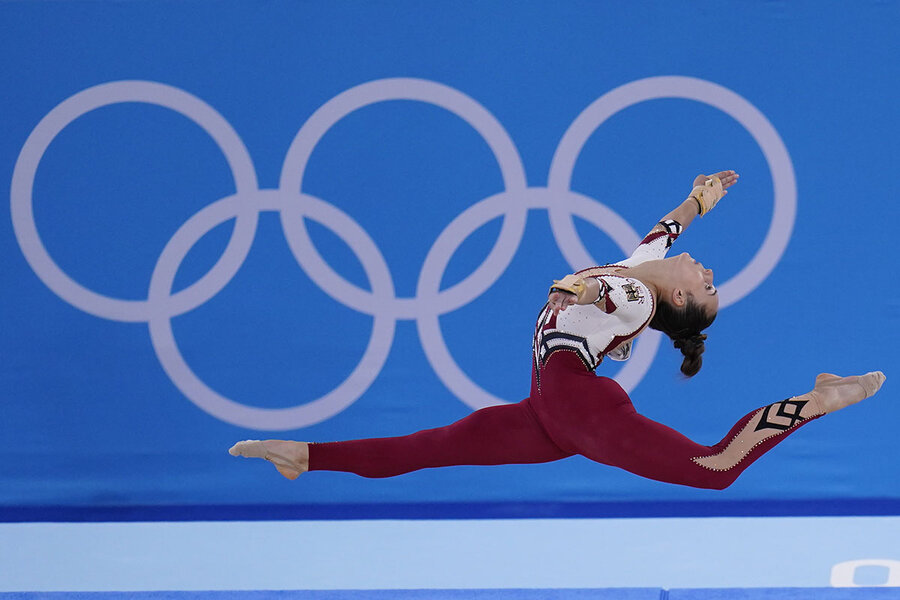Why Katie Ledecky’s gold represents something bigger at the Games
Loading...
| Tokyo
Pierre de Coubertin, architect of the modern Olympics, intended the competition to celebrate masculine athletic prowess. “An Olympiad with females,” he once said, “would be impractical, uninteresting, unaesthetic and improper.”
By 1900, though, women had made it to the Games – but in sports considered properly delicate, like tennis and croquet. For decades, organizers barred women from long-distance competitions, fearing the strain would be too much.
Why We Wrote This
By some measures, the Tokyo Games are the most gender-equal Olympics in history. But female athletes caution there’s still a long way to go before they’re given the same opportunities – and respect – as their male peers.
More than a century later, things have changed. Forty-nine percent of the athletes in Tokyo are women, making this Olympics the most gender-balanced in history. Its most famous contenders, such as Simone Biles and Naomi Osaka, are women. So are its most dominant teams, such as U.S. women’s water polo.
But there’s a long road yet to equality, female athletes say – and they’re breaking new ground this summer. Katie Ledecky’s gold medal in the 1,500-meter freestyle swim, for example, was not just a personal victory. It was the first time that event had been open to women.
A new generation of athletes has a new vision of equality, said silver medalist Erica Sullivan. “Getting to be on the podium in Japan as an Asian American woman and getting to take silver in a historical women’s event ... it’s so cool,” she said. “It’s just so cool.”
Katie Ledecky, perhaps the greatest female distance swimmer of all time, has dominated the women’s 1,500-meter freestyle for the better part of a decade. At one point this week, she held the 11 fastest times in its history. Her world-record time is 18 seconds ahead of the second-fastest finisher.
But until Wednesday, Ms. Ledecky didn’t have an Olympic medal in the event. For decades, the 1,500-meter was only available to men.
After a disappointing 200-meter final, Ms. Ledecky had an hour to rally herself for the mile-long race. When she entered the pool again, it wasn’t close. She spent the entire race multiple lengths ahead of the competition, and finished four seconds ahead of second-place Erica Sullivan, her teammate.
Why We Wrote This
By some measures, the Tokyo Games are the most gender-equal Olympics in history. But female athletes caution there’s still a long way to go before they’re given the same opportunities – and respect – as their male peers.
“I’m so happy to go one-two there with Erica on the first women’s mile,” Ms. Ledecky said right after the race. “Can’t have a better outcome than that.”
Her gold marked a personal triumph during a difficult week, including her fifth-place finish in the 200-meter – her first Olympic finish off the podium. But the medal – and the race itself – also marked a symbolic victory for female athletes at the Games. The women’s 1,500-meter had never before featured at the Olympics, which has a long history of restricting women from long-distance events. The women’s marathon, for instance, wasn’t added until the 1984 Summer Olympics.
With just under 49% of all athletes being women, the Tokyo Games are the most gender-balanced in history. Its most famous contenders, such as Simone Biles and Naomi Osaka, are women. Its most dominant teams, such as U.S. women’s water polo, are as well. Once a rarity, mixed-gender events in sports such as swim relays and table tennis are becoming more common. More than ever, women at the Olympics are calling for equal treatment.
Yet even as the Paris Games in 2024 promise more progress toward gender equality, hurdles for female athletes remain steep. Symbolism and statistical progress are welcome, but numbers can hide as much as they reveal, says Michelle O’Shea, a senior lecturer in marketing and sport at Western Sydney University. A litany of controversies coming just before the Games – from gendered uniforms to sexist comments – displays a culture still in need of reform.
The circumstances leave female Olympians in a familiar spot, says Professor O’Shea: somewhere between celebration and lamentation. The Olympic Games have made great strides in gender equity since their founding, she adds, but the only way to make sure those continue is to stay active.
“We want to celebrate the wins and we want to celebrate the change,” says Professor O’Shea. “But ... we’ve still got to do better.”
Long road
Still, in the Olympics’ 125-year history, there’s never been a better time for women at the Games.
Pierre de Coubertin, architect of the modern Olympics, intended the competition to celebrate masculine athletic prowess. “An Olympiad with females,” he once said, “would be impractical, uninteresting, unaesthetic and improper.”
While women competed in the second modern Olympics in 1900, men dictated their participation. Permitted competitions included tennis and croquet, both considered delicate and properly feminine. For decades, organizers barred women from long-distance competitions, fearing the strain would be too much.
Even now, athletes say they’re challenged to dismantle that culture.
Today, nearly two-thirds of International Olympic Committee members are men. While the athletes’ gender balance may almost be equal, coaches and trainers are still disproportionately male. Media coverage, per a Cambridge University analysis of the 2016 Games in Rio de Janeiro, can amplify inequities by infantilizing female athletes – or focusing on their marriages to male competitors.
German gymnasts wore full-length leotards this week, protesting the sexualization of female athletes. The first head of the Tokyo Olympic organizing committee resigned after suggesting women talk too much in meetings. Five-time Olympian Allyson Felix and other mothers at the Games had to fight sponsors and organizers for equal treatment after giving birth. Australian swimmer Maddie Groves stepped away from the sport, citing a culture of misogyny.
Yet “in spite of all the things that have gone wrong and all the areas that we still need to improve upon, I feel like the pace of change has accelerated in the last five years,” says Sarah Duffy, also a senior lecturer of marketing and sport at Western Sydney University and Professor O’Shea’s colleague.
Once disproportionately allocated to men’s sports, prime-time broadcast slots are now split more evenly between genders. Almost every nation appointed a male and female flag bearer at the opening ceremony. Naomi Osaka, an iconic athlete in a country that still ranks low in gender equality, lit the Olympic cauldron.
“It always takes that first person”
That progress, in large part, is a product of athletes who have accepted its costs.
“It’s unfortunate that there’s this process ... that we have to go through,” said U.S. flag bearer and basketball veteran Sue Bird.
An athlete or team protests inequity and meets resistance from organizers, she added, only to see the inequity addressed years later. Reform comes, but those who helped force it rarely experience its benefits.
“It always takes that first person or that first team to stand their ground,” said Ms. Bird. “And I don’t know why it has to be that way.”
One “first” in Tokyo is women’s featherweight boxing, a weight class added just this year. Until 2012, women weren’t allowed to box in the Olympics at all, and the sport’s foothold has grown at each Games since.
“The equality between both male and female has come a long way,” said American featherweight Yarisel Ramirez after being eliminated in the round of 32. Being here “is a good, prime example ... that us women are just as equal as the men.”
Back at the pool, finishes like Ms. Sullivan’s set an example as well.
On Wednesday, she cut several seconds off her qualifying time from Sunday, finishing four seconds behind Ms. Ledecky in the 1,500-meter final.
It was a difficult year training in Ms. Sullivan’s native Nevada. At one point during the pandemic, she swam in a neighbor’s single-lane 25-meter pool. At another, she and her team trained in the swampy waters of Lake Meade, emerging covered in bug bites. She’d never finished so close to Ms. Ledecky, an idol of hers, and didn’t expect to in the 1,500-meter final, either.
But for Ms. Sullivan – the daughter of a Japanese immigrant, and who identifies as queer – a silver medal is a symbolic victory for a new generation of American athletes, who look and act different than Olympians of the past. That generation, she says, has a new vision of equality.
“Getting to be on the podium in Japan as an Asian American woman and getting to take silver in a historical women’s event ... it’s so cool,” she said. “It’s just so cool.”









